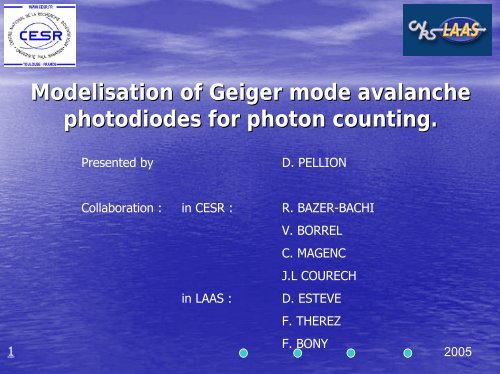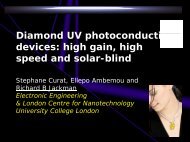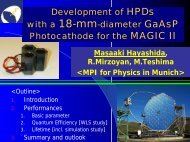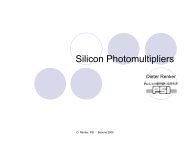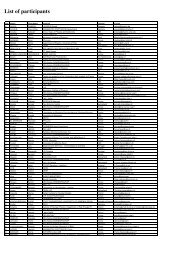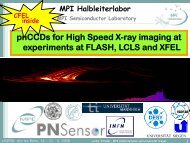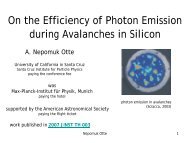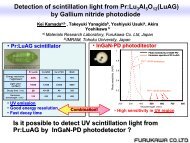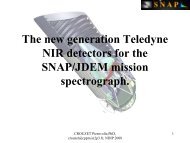APD photodetectors in the Geiger photon counter mode
APD photodetectors in the Geiger photon counter mode
APD photodetectors in the Geiger photon counter mode
Create successful ePaper yourself
Turn your PDF publications into a flip-book with our unique Google optimized e-Paper software.
Modelisation of <strong>Geiger</strong> <strong>mode</strong> avalanche<br />
photodiodes for <strong>photon</strong> count<strong>in</strong>g. count<strong>in</strong>g<br />
Presented by D. PELLION<br />
Collaboration : <strong>in</strong> CESR : R. BAZER-BACHI<br />
V. BORREL<br />
C. MAGENC<br />
J.L COURECH<br />
<strong>in</strong> LAAS : D. ESTEVE<br />
F. THEREZ<br />
F. BONY<br />
1 2005
2<br />
Summary<br />
• Introduction<br />
Light detection, state of art<br />
Objective of this work<br />
• Avalanche photodiodes <strong>in</strong> <strong>Geiger</strong> <strong>mode</strong> (<strong>Geiger</strong> ( <strong>Geiger</strong>-<strong>APD</strong> <strong>APD</strong>)<br />
Pr<strong>in</strong>ciple<br />
• Modelization<br />
physical Modelization<br />
electrical Modelization<br />
• The read<strong>in</strong>g and control circuit<br />
• Experimental visualization<br />
test bench<br />
samples of oscillograms<br />
• Conclusion<br />
Utilization of <strong>the</strong>se results to def<strong>in</strong>e <strong>the</strong> technology of a <strong>Geiger</strong> <strong>APD</strong>
3<br />
Introduction<br />
• Photomultipliers (PMT),<br />
• Avalanche Photodiodes (<strong>APD</strong>).<br />
• Objective of this work<br />
– Avalanche Photodiodes <strong>in</strong> <strong>Geiger</strong> <strong>mode</strong> (<strong>Geiger</strong> ( <strong>Geiger</strong>-<strong>APD</strong> <strong>APD</strong>). ).<br />
Multiplication<br />
Estimated Performances<br />
PM <strong>APD</strong> <strong>Geiger</strong>-<strong>APD</strong><br />
10 6 to 10 9 50 to 100 10 3 to 10 9<br />
Photon count<strong>in</strong>g Yes No Yes<br />
Quantum efficiency 20% 80% 80%<br />
T=20°C<br />
λ= optimal
4<br />
Avalanche photodiodes <strong>in</strong> <strong>Geiger</strong><br />
<strong>mode</strong> (<strong>Geiger</strong>-<strong>APD</strong>)<br />
• <strong>Geiger</strong> Polarization<br />
I<br />
Pr<strong>in</strong>ciple of <strong>the</strong> <strong>Geiger</strong> <strong>mode</strong><br />
Performances<br />
Problems, Problems,<br />
Limitations<br />
Zone A Zone B<br />
Vrepos Vav VG Figure 3 : static behaviaur of a p-n jonction<br />
Now: dead time is 1ns to 10ns<br />
V<br />
Zone A Zone B<br />
V G<br />
V av<br />
V<br />
V repos<br />
I<br />
Event<br />
dead time<br />
Figure 1 : Voltage across <strong>the</strong> photodiode<br />
Figure 2 : Current across <strong>the</strong> photodiode<br />
t<br />
t
Modelization<br />
• Physique Modelization<br />
di ( t )<br />
dt<br />
M ( t )<br />
V<br />
( t )<br />
=<br />
=<br />
=<br />
v<br />
M ( t ) ⋅ ⋅ i(<br />
t )<br />
w<br />
fct ( V ( t ), t )<br />
1 t<br />
V G − ∫ i ( t ). dt<br />
C i<br />
0<br />
i(t) <strong>in</strong>creas<strong>in</strong>g or decreas<strong>in</strong>g exponential<br />
i<br />
V<br />
VG VAV V static<br />
M(t) Experimental<br />
10<br />
V(t) charge of <strong>the</strong> capacitor from Vrepos to VG<br />
discharge of a capacitor from VG to Vav<br />
5<br />
104 VG to Vav 103 10 5<br />
10 4<br />
10 3<br />
Ga<strong>in</strong> <strong>in</strong> <strong>Geiger</strong> <strong>mode</strong><br />
1<br />
2 3<br />
Dark counts<br />
5 6<br />
2 3<br />
1<br />
Ga<strong>in</strong> <strong>in</strong> <strong>Geiger</strong> <strong>mode</strong><br />
G = Cpix.(Vbias – Vbreak)/e<br />
6<br />
t<br />
t<br />
V G -V AV<br />
V G -V AV
6<br />
Modelization<br />
• Electrical Modelization (VHDL-AMS)<br />
(VHDL AMS)<br />
Vdiode = V G<br />
Cd<br />
Rd<br />
I<br />
V av<br />
Cd : represents <strong>the</strong> capacitance of <strong>the</strong><br />
photodiode : 1pF<br />
Rd : to <strong>mode</strong>l <strong>the</strong> decrease of <strong>the</strong><br />
polarization of <strong>the</strong> photodiode dur<strong>in</strong>g <strong>the</strong><br />
avalanche : 100 Ohms<br />
I : <strong>the</strong> clos<strong>in</strong>g of I <strong>in</strong>duces a voltage<br />
drop from V G to V AV
V 20<br />
V 140<br />
The read<strong>in</strong>g and control circuit<br />
Rch<br />
A<br />
R 4<br />
T4<br />
<strong>APD</strong><br />
(Cd, Rd)<br />
R 3<br />
C<br />
T3<br />
Avalanche active quench<strong>in</strong>g electronics.<br />
R 2<br />
T2<br />
T1<br />
B<br />
R 1
8<br />
Experimental Visualisation<br />
• mesur<strong>in</strong>g circuit<br />
circuit to visualize <strong>the</strong> avalanche<br />
• Results<br />
VG Vav V repos<br />
1,3µs<br />
V 1 = 25V V repos = 140V<br />
R1 = 1k<br />
V R1<br />
G<br />
S<br />
D<br />
V DS<br />
V D1<br />
R2 = 50<br />
V R2<br />
1 mA<br />
0 V<br />
1,3µs<br />
Term<strong>in</strong>al Voltage of <strong>the</strong> photodiode Current across <strong>the</strong> photodiode
I(mA)<br />
5 mA<br />
0 mA<br />
Estimation of <strong>the</strong> amplification :<br />
Ga<strong>in</strong> <strong>in</strong> <strong>Geiger</strong> <strong>mode</strong><br />
0,1 ns<br />
t(s)<br />
(19 mA * 100 ps) / 2 = 9,5*10-13 coul.<br />
8*10-14 coul. / 1,6 *10-19 coul. = 6 000 000 electron.<br />
Or G = Cpix.(Vbias – Vbreak)/e<br />
= 1pF * 1V /q<br />
= 6 000 000 electron
10<br />
Conclusion<br />
• Fabrication of <strong>Geiger</strong> diodes<br />
Low voltage<br />
Small capacitance<br />
Very small noise current (<strong>the</strong>rmal)<br />
• Fabrication of an array of <strong>Geiger</strong> diodes<br />
Next results to be presented<br />
metal<br />
L eff<br />
P +<br />
P +<br />
N ++<br />
P -


